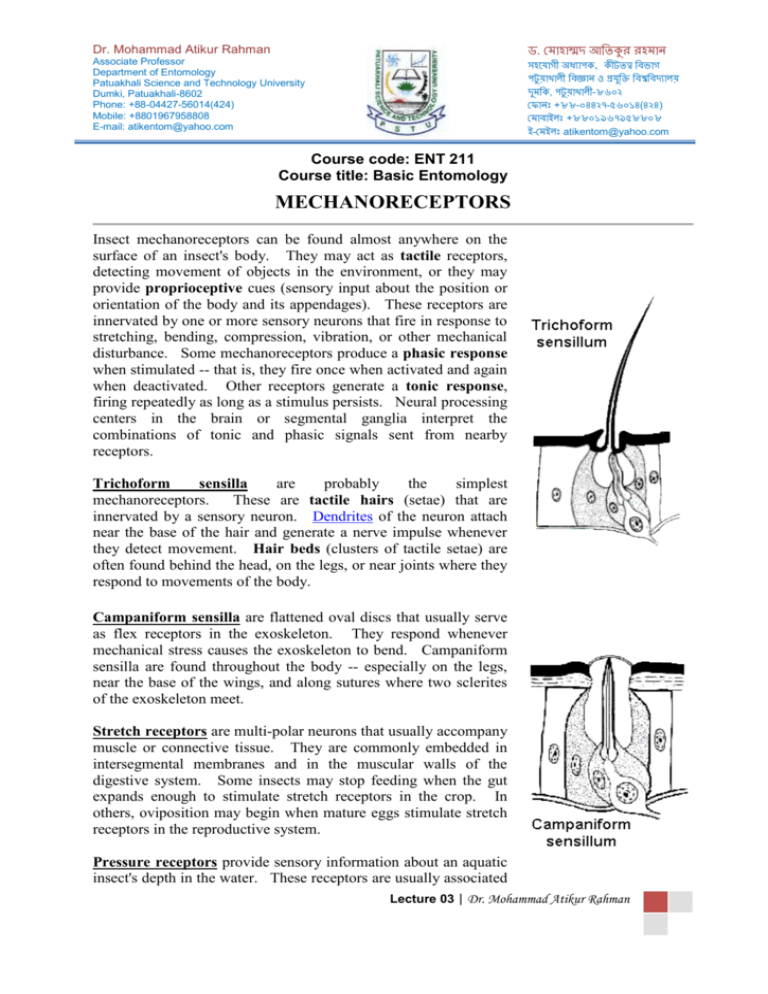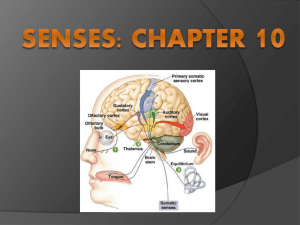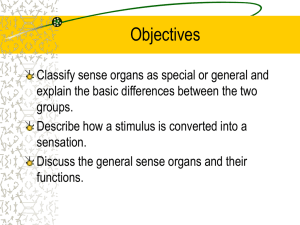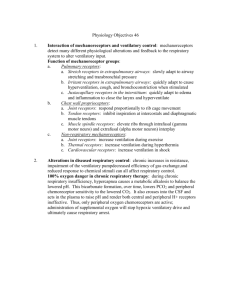mechanoreceptors
advertisement

ড. ম োহোম্মদ আতিকুর রহ োন Dr. Mohammad Atikur Rahman Associate Professor Department of Entomology Patuakhali Science and Technology University Dumki, Patuakhali-8602 Phone: +88-04427-56014(424) Mobile: +8801967958808 E-mail: atikentom@yahoo.com সহয োগী অধ্যোপক, কীটিত্ত্ব তিভোগ পটু য়োখোলী তিজ্ঞোন ও প্র ুতি তিশ্বতিদযোলয় দু তক, পটু য়োখোলী-৮৬০২ ম োনঃ +৮৮-০৪৪২৭-৫৬০১৪(৪২৪) ম োিোইলঃ +৮৮০১৯৬৭৯৫৮৮০৮ ই-ম ইলঃ atikentom@yahoo.com Course code: ENT 211 Course title: Basic Entomology MECHANORECEPTORS Insect mechanoreceptors can be found almost anywhere on the surface of an insect's body. They may act as tactile receptors, detecting movement of objects in the environment, or they may provide proprioceptive cues (sensory input about the position or orientation of the body and its appendages). These receptors are innervated by one or more sensory neurons that fire in response to stretching, bending, compression, vibration, or other mechanical disturbance. Some mechanoreceptors produce a phasic response when stimulated -- that is, they fire once when activated and again when deactivated. Other receptors generate a tonic response, firing repeatedly as long as a stimulus persists. Neural processing centers in the brain or segmental ganglia interpret the combinations of tonic and phasic signals sent from nearby receptors. Trichoform sensilla are probably the simplest mechanoreceptors. These are tactile hairs (setae) that are innervated by a sensory neuron. Dendrites of the neuron attach near the base of the hair and generate a nerve impulse whenever they detect movement. Hair beds (clusters of tactile setae) are often found behind the head, on the legs, or near joints where they respond to movements of the body. Campaniform sensilla are flattened oval discs that usually serve as flex receptors in the exoskeleton. They respond whenever mechanical stress causes the exoskeleton to bend. Campaniform sensilla are found throughout the body -- especially on the legs, near the base of the wings, and along sutures where two sclerites of the exoskeleton meet. Stretch receptors are multi-polar neurons that usually accompany muscle or connective tissue. They are commonly embedded in intersegmental membranes and in the muscular walls of the digestive system. Some insects may stop feeding when the gut expands enough to stimulate stretch receptors in the crop. In others, oviposition may begin when mature eggs stimulate stretch receptors in the reproductive system. Pressure receptors provide sensory information about an aquatic insect's depth in the water. These receptors are usually associated Lecture 03 | Dr. Mohammad Atikur Rahman with a cushion of air against the body or within the tracheal system. Increasing water pressure deflects hair-like processes within the receptor and stimulates tonic and phasic impulses. Chordotonal organs include several types of mechanoreceptors in which one or more bipolar neurons bridge a gap between two internal surfaces of the exoskeleton. Each neuron is usually accompanied by two other cells which form a sheath (the scolopale cell) and a point of attachment (the cap cell). Together, these three cells create a unit (called a scolopidia) that may occur singly or in groups. Common types of chordotonal organs include: Subgenual organs -- located in the legs of many insects, these receptors contain relatively few scolopidia yet they appear to be very sensitive to substrate vibrations. Insects may lack specialized sound receptors, yet they can still "hear" vibrations transmitted through the substrate. Tympanal organs -- lie beneath a drum-like membrane (the tympanum) where they respond to sound vibrations. These "ears" may be located on the thorax (in some Hemiptera), on the abdomen (in grasshoppers, cicadas, and some moths), or on the front tibia (in crickets and katydids). Johnston's organs -- found within the pedicel of each antenna. In some insects, they function as a proprioceptors, supplying information on position or orientation of the antennae. In mosquitoes and midges, they respond to certain frequencies of airborne sound by detecting resonant vibrations in antennal hairs. (Shorter hairs near the tip of the antennae resonate to higher frequencies than longer hairs near the base). Lecture 03 | Dr. Mohammad Atikur Rahman







